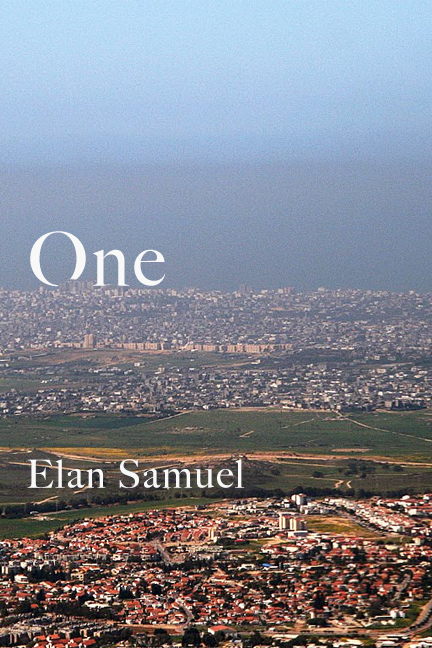Welcome to another great installment of World Builders! Today I’m happy to welcome Elan Samuel, author of the near future scifi book, One.
 By day, Elan Samuel is a writer and editor for an advertising technologies company in San Francisco. By night, he writes fiction and reviews books of all kinds on his blog, The Warbler. His wildest dreams include becoming a published author and building a career in which he can read all day, preferably by a body of water.
By day, Elan Samuel is a writer and editor for an advertising technologies company in San Francisco. By night, he writes fiction and reviews books of all kinds on his blog, The Warbler. His wildest dreams include becoming a published author and building a career in which he can read all day, preferably by a body of water.
I connected with Elan when he became a fan of Blood Dawn, and was excited to see what he was up to in his own fiction as well. Here now are Elan’s insights on world building.
What is the appeal of world building to you? How does it compare to the importance of character and plot?
One of the greatest gifts of speculative fiction is that it allows us to — yes — speculate on what might happen if. The opportunity presented to us by building rich, diverse, different, stunning, foreign, beautiful worlds is one that is endlessly exciting. We can take the most outlandish idea, breathe life into it, and as long as there is a mechanism through which we can relate to it (the emotions of a character in response to the world, for instance), we can travel there.
Often in scifi and fantasy, the world is as much a character as the actors who live within it. The world can become the crux of the plot, speak to the characters directly, or thwart them in their quest. The balance of world, character, and plot depends heavily on the story you’re trying to tell. At the same time, a rich world loses its impact when ill-thought-out characters fill it, and a beautiful world with deep characters which lacks in plot is little more than an encyclopedia. At the end of the day, the best book works world, character, and plot in tandem to build a believable, engaging, and rich story.
How do you avoid excessive world building and balance it with the act of writing the story?
I’m working on an epic fantasy set in a world that is, ecologically speaking, very different from our world. I spent a little while on the “wow factor” of the world, but found myself itching to write characters within it. I’m a discovery writer — despite efforts to transition to outlines — and I’ve found that as I write this particular piece, elements of the world come into existence on the fly. This can be pretty dangerous, because I run the risk of building world so convoluted and piecemeal as to not be believable or entertaining. I’ve found that when a new fact about the world pops into existence, I pause at the nearest convenient spot, and work toward reconciling the new detail with my existing lore, making sure it fits neatly before moving on. So far, it hasn’t failed me too much.
I also have the benefit of having a kind and very patient girlfriend, who listens and offers suggestions as I work through ideas. I highly recommend talking through your ideas out loud with a friend if you’re struggling with your world.
Have you learned tips on world building from other authors in your genre? If so, what are they?
I listen to the Writing Excuses podcast, which I highly recommend to any and every writer. Their tips and lessons are invaluable, the podcast is very fun, and their writing prompts have sparked entire novels in my mind. One of the crucial notions covered on the podcast was that the concept of the “glacier” in world building is somewhat erroneous.
The “glacier” refers to the idea that the world you show the reader is 30% of the world you’ve built, and that the unseen 70% of your work can be understood (or partially acknowledged) by implication and inference within the novel. This is an enormous amount of work that you won’t be sharing with your reader! The key difference, according to the folks at Writing Excuses, is that you don’t have to flesh out that part of the world in the background. Rather, you have to imply its existence in the foreground. That way your world continues to feel expansive without the need for extensive planning and world building. It also allows an open-endedness that can help with the creation of sequels or additional in-world tales.
Describe your world and some of the considerations behind it that you feel give your stories a solid sense of realism:
Building the world for One, the book I’ve got entered in the Inkshares/Nerdist contest, presented a new challenge, because I’m not building a new world. I’m building a science-fiction element into a volatile, controversial area of our very real world.
The story takes place in Israel and Gaza, and in an attempt to remove as much political posturing from the story as possible, I’m creating a third, non-existent entity which challenges our protagonists. Nonetheless, the groups involved in the story — Secular Israeli Jews, Secular Palestinian Muslims, Hamas, Orthodox Jews, atheists from both sides — are very real, and a delicate subject at the best of times. By building a story focused not on the merits of any side of the conflict, but shedding light on it then turning the attention of the reader to focus on the experiences of the characters, I hope to tell an engaging story in a setting with deep personal meaning for me.
Now here’s more on Elan’s book, One:
 One consciousness is shared by two children across the border of one of the most divisive conflicts of our time. To survive, they’ll need to work together to avoid religious idealists, political interest groups, and something more nefarious altogether.
One consciousness is shared by two children across the border of one of the most divisive conflicts of our time. To survive, they’ll need to work together to avoid religious idealists, political interest groups, and something more nefarious altogether.
Here is an excerpt:
I first got my glasses when I was really little, but they don’t help. The doctors didn’t understand what was wrong with my eyes, but they hoped that the glasses would fix whatever it is. They make things a little worse, so I take them off when I leave the house. Eema doesn’t know I take the glasses off. I’m nine now, and she doesn’t have to know about it. I do pretty well for seeing double all the time. Well, not all the time. Most of the time.
There’s a game I play when I walk to the bus stop. When I close my eyes, I only see once, so I try to walk the safest path — from shelter to shelter — from memory, and focus on the other world that I am seeing. Sometimes I can figure out what it is, but most of the time, its just a blur of colors and movement. I’m nine, and I learned to tune it out when I have my eyes open, mostly. Eema says the glasses should help, and that the headaches will go away when I wear them. When I was young, I would tell her about the headaches. Now that I’m almost ten, I don’t bother.
Once, when I was six, I tried poking the lenses out of the glasses. Eema was very mad at me, but was worried when I told her they gave me headaches. So we went back to the doctor, and I sat in the chair and looked through the big machine that looked like it was from a movie, and when the doctor asked, echad oh shtayim, over and over again, I played a little game where I would change my answers every time he asked.
I couldn’t see at all through the next pair of glasses, so we went back to the doctor, and the doctor just shrugged and Eema got upset, so he called in the next eye doctor. I don’t like the way they shine their lights into my eyes, because it makes the double vision worse. I don’t like to lie, but I do it because now I don’t have to go to the eye doctors as much anymore.
When I play the bus-stop-memory-game, I try to figure out what I see in the backs of my eyelids, but sometimes I don’t see anything. Eema wouldn’t like the bus-stop-memory-game, because it’s dangerous. I know it is, but I play anyway. It’s not like I’m ever that far from a bomb shelter. Here, in Sderot, the rule is that you can never be more than 30 seconds away from one, ever. So they are everywhere.
Bombs fall a lot here, and if I’m not walking to the bus stop or at school, they don’t really scare me. There are the loud sirens and then you run and hide. When you come out from the shelter, there are new holes in the street, or maybe somebody’s house was hit, but the shelters protect us, mostly. Sometimes people die.
A reviews for One:
“This. So much this. Though the first chapter is rough, I am very intrigued by the notion that two children on opposite sides of a monumental conflict share a consciousness. I sincerely hope this novel gets enough backing be published. What an amazing concept that has the potential to stop and make the reader think; to TRULY humanize a conflict that seems so “far away” from the rest of the world, and see it “through the eyes” (literally and figuratively) of a child in the midst of all of the destruction. Truth springs from the mouths of babes.” —Suraya Mattocks
If you enjoyed what you read here and would like to help bring this book to life, please go over to Inkshares cast your vote by pre-ordering a copy.
Inkshares is a crowdfunding publisher who chooses which books to publish based on whether enough readers have shown interest in them. Successful projects have been reviewed in the NYT, US Today, and Washington Post, and have been distributed to numerous bookstores including Indigo and Barnes & Noble.
You can also connected with Elan in the following places:
Website: www.elansamuel.com
Blog: www.thewarblerbooks.com
Twitter: @Bonbonelan / @Warbler_Books
Facebook: www.facebook.com/thewarblerbooks
Tumblr: http://warblerlite.tumblr.com
Email: editor “at” thewarblerbooks “dot” com


Thank you for the opportunity, John! Your questions were very thought provoking…made me want to build new worlds!